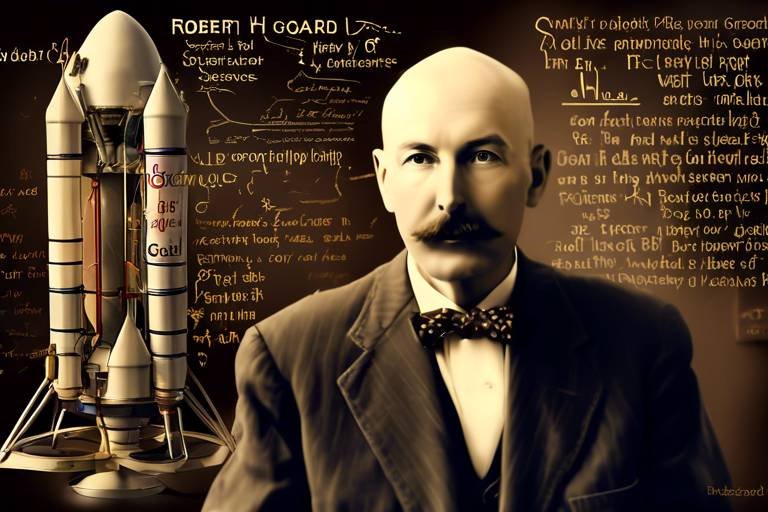The Pioneering Research of Frances Arnold in Enzyme Engineering
Frances Arnold's groundbreaking work in enzyme engineering has not only transformed the field of biochemistry but has also paved the way for innovative applications across various industries. Her relentless pursuit of knowledge and her unique approach to scientific challenges have made her a trailblazer in the realm of synthetic biology. By harnessing the power of enzymes, Arnold has unlocked a treasure trove of possibilities that extend far beyond traditional methods, revolutionizing how we think about chemical processes.
Arnold's journey began with a simple yet profound question: How can we make enzymes work better? This curiosity led her to develop pioneering techniques that have become the gold standard in enzyme engineering. One of her most notable contributions is the concept of directed evolution, a method that mimics natural selection to create enzymes with enhanced functions. Imagine a sculptor chiseling away at a block of marble, gradually revealing a masterpiece; this is akin to how Arnold's methods refine enzymes to achieve optimal performance.
Her innovative techniques have significant implications for biotechnology, especially in creating more efficient processes for drug production, biofuels, and even environmental remediation. For instance, in the pharmaceutical industry, enzymes engineered through Arnold's methods can lead to the synthesis of complex drugs in a more sustainable manner, reducing the need for harsh chemicals and minimizing waste. This not only makes drug production more environmentally friendly but also enhances the efficiency of the entire manufacturing process.
Moreover, Arnold's research extends beyond the lab bench. Her work has inspired a new generation of scientists who are eager to explore the potential of enzyme engineering. By fostering a culture of mentorship and collaboration, she has cultivated an environment where innovation thrives. The partnerships she has formed with various institutions and industries serve as a testament to the power of teamwork in scientific advancement. Together, they are pushing the boundaries of what is possible, proving that when bright minds come together, the results can be nothing short of extraordinary.
In summary, Frances Arnold's pioneering research in enzyme engineering is a shining example of how curiosity and creativity can lead to groundbreaking discoveries. Her innovative techniques not only enhance our understanding of biochemistry but also have far-reaching implications for sustainability and industrial processes. As we continue to explore the potential of enzyme engineering, one thing is clear: Arnold's legacy will inspire future generations to think outside the box and strive for excellence in science.
- What is enzyme engineering? Enzyme engineering involves the design and modification of enzymes to improve their efficiency and specificity for various applications.
- How did Frances Arnold contribute to enzyme engineering? Frances Arnold developed the technique of directed evolution, which allows scientists to create enzymes with enhanced properties through a process that mimics natural selection.
- What industries benefit from enzyme engineering? Industries such as pharmaceuticals, biofuels, and environmental remediation greatly benefit from advancements in enzyme engineering.
- What is directed evolution? Directed evolution is a method used to mimic the process of natural selection in the laboratory, allowing researchers to evolve proteins or nucleic acids toward a user-defined goal.

Frances Arnold: A Trailblazer in Science
Frances Arnold's journey in the realm of science is nothing short of inspirational. With an insatiable curiosity and a determination to push the boundaries of what is possible, she has emerged as a leading figure in the field of enzyme engineering. Her work is characterized by a blend of creativity and rigorous scientific methodology, which has not only advanced the understanding of enzymes but has also revolutionized their applications across various industries.
Born in 1956, Arnold's early fascination with science was evident. She pursued her education with vigor, earning her bachelor’s degree in mechanical and aerospace engineering from Princeton University. However, her true passion lay in biochemistry, prompting her to obtain a Ph.D. from the University of California, Berkeley. It was here that she began to explore the intricate world of enzymes, which are nature's catalysts, speeding up chemical reactions in living organisms.
Arnold is best known for pioneering the technique known as directed evolution, a groundbreaking approach that mimics natural selection in the laboratory. This innovative method allows scientists to engineer enzymes with specific desired traits, enhancing their efficiency and effectiveness. Imagine being able to create a tool that can adapt and improve over time—this is essentially what Arnold has achieved with enzymes.
Her relentless pursuit of knowledge and innovation has led to significant breakthroughs that have had a profound impact on various sectors. For instance, in the pharmaceutical industry, her engineered enzymes are used to produce drugs more efficiently and sustainably. This not only reduces costs but also minimizes environmental impact, showcasing how science can serve both industry and the planet.
Moreover, Arnold's work extends beyond the laboratory. She is a passionate advocate for diversity and inclusion in science, believing that a variety of perspectives leads to greater innovation. Her commitment to mentorship has inspired countless young scientists, particularly women, to pursue careers in STEM fields. By sharing her journey and knowledge, she is paving the way for the next generation of trailblazers.
In recognition of her remarkable contributions, Arnold has received numerous awards, including the prestigious National Medal of Technology and Innovation. These accolades not only honor her achievements but also highlight the importance of her work in advancing our understanding of biochemistry and its applications. As we delve deeper into her research and its implications, it becomes clear that Frances Arnold is not just a scientist; she is a true pioneer, shaping the future of science and technology.

The Mechanisms of Enzyme Engineering
Enzyme engineering is a fascinating field that combines the principles of biology, chemistry, and engineering to create enzymes with tailored functionalities. At its core, enzyme engineering seeks to enhance or modify the natural capabilities of enzymes—biological catalysts that speed up chemical reactions. To fully appreciate the revolutionary work of Frances Arnold, it’s essential to grasp the underlying mechanisms that make enzyme engineering possible. This involves understanding how enzymes function, how they can be manipulated, and the innovative techniques that Arnold pioneered.
One of the foundational principles of enzyme engineering is the concept of protein structure and function. Enzymes are proteins, and their three-dimensional structures determine their activity. By altering the amino acid sequence of an enzyme, scientists can change its structure, and consequently, its function. This is akin to changing the gears in a car; just as different gears affect speed and efficiency, different amino acid configurations can enhance an enzyme's catalytic properties.
Frances Arnold's groundbreaking approach to enzyme engineering is primarily centered on the method known as directed evolution. This technique mimics natural selection in the laboratory, allowing researchers to evolve enzymes with desired traits over successive generations. The process involves several key steps:
- Library Creation: Scientists create a diverse library of enzyme variants by introducing random mutations into the DNA sequence that encodes the enzyme.
- Screening: These variants are then screened for improved activity or stability. This step is critical as it identifies the most promising candidates for further development.
- Selection: The best-performing variants are selected for additional rounds of mutation and screening, gradually enhancing their properties.
This iterative process can lead to enzymes that are not only more efficient but also capable of functioning under extreme conditions—such as high temperatures or varying pH levels—making them invaluable in industrial applications. For instance, enzymes engineered through this method have found applications in the production of biofuels, where they help break down plant materials more efficiently.
Another important aspect of enzyme engineering is understanding the enzyme kinetics, which refers to the rates of enzyme-catalyzed reactions. By studying these kinetics, scientists can identify the optimal conditions for enzyme activity and make informed adjustments to enhance performance. This is crucial in industries such as pharmaceuticals, where maximizing reaction efficiency can lead to significant cost savings and reduced environmental impact.
Moreover, enzyme engineering leverages advanced techniques such as computational modeling and machine learning. These technologies allow researchers to predict how changes to an enzyme's structure will affect its function, thereby streamlining the design process. Imagine having a sophisticated GPS system that not only tells you the best route but also predicts traffic patterns ahead; similarly, computational tools can guide scientists in their quest to engineer the perfect enzyme.
In summary, the mechanisms of enzyme engineering are complex yet fascinating, involving a blend of biological understanding, innovative techniques, and cutting-edge technology. Frances Arnold’s contributions have not only propelled the field forward but have also opened up new avenues for research and application. As we delve deeper into the implications of her work, it becomes clear that enzyme engineering is poised to play a critical role in the future of biotechnology and sustainable practices.

Directed Evolution of Enzymes
When it comes to revolutionizing the field of enzyme engineering, directed evolution stands out as a game-changing technique that has transformed the way scientists approach the creation of enzymes. Imagine a process similar to natural selection, where the best traits are preserved and passed on, but instead of waiting for eons, this evolution occurs in the laboratory within weeks or even days! Frances Arnold pioneered this method, allowing researchers to rapidly develop enzymes with enhanced properties tailored for specific applications.
So, how does this fascinating process work? At its core, directed evolution involves a few key steps:
- Library Creation: Scientists create a diverse library of enzyme variants through techniques such as mutagenesis, where the DNA encoding the enzyme is intentionally altered to introduce mutations.
- Screening: Each variant is tested for its performance in a specific reaction. This is akin to a talent show, where only the best performers make it to the next round.
- Selection: The top-performing enzymes are selected and subjected to further rounds of mutation and screening, honing in on the most effective variants.
This iterative process not only accelerates the development of enzymes but also enables the creation of enzymes that nature may not produce on its own. For instance, Arnold's work has led to enzymes that can function under extreme conditions, such as high temperatures or acidic environments, making them invaluable in industrial applications.
The impact of directed evolution extends far beyond the laboratory. In the pharmaceutical industry, for example, enzymes engineered through this method are used in the production of drugs, allowing for more efficient synthesis pathways and reducing the need for harsh chemicals. This not only enhances product yield but also contributes to sustainability by minimizing waste and energy consumption.
Moreover, directed evolution has opened doors to novel applications in various sectors, including:
- Biofuels: Enzymes optimized for breaking down plant materials can lead to more efficient biofuel production.
- Food Industry: Enhanced enzymes improve processes like fermentation, leading to better quality products.
- Environmental Remediation: Custom enzymes can be designed to break down pollutants, aiding in cleanup efforts.
In summary, directed evolution is not just a technique; it's a revolutionary approach that has paved the way for innovative solutions across multiple industries. Frances Arnold's contributions in this area have not only advanced our understanding of enzyme functionality but have also set the stage for a more sustainable and efficient future.

Applications in Pharmaceuticals
Frances Arnold's pioneering work in enzyme engineering has revolutionized the pharmaceutical industry, leading to the development of more efficient and sustainable drug production methods. By harnessing the power of enzymes, scientists can now create drugs that are not only more effective but also produced with significantly less environmental impact. Imagine a world where the production of life-saving medications is less resource-intensive and more aligned with the principles of sustainability—this is the reality that Arnold's innovations are helping to create.
One of the most significant advancements brought about by Arnold's research is the ability to produce chiral compounds more efficiently. Chiral compounds are essential in pharmaceuticals because many drugs exist as two mirror-image forms, known as enantiomers. One form may be therapeutically beneficial, while the other could be harmful. Traditional methods of producing these compounds often involve complex and wasteful chemical processes. However, with Arnold's directed evolution techniques, enzymes can be engineered to selectively produce the desired enantiomer, dramatically improving both the yield and purity of the final product.
Furthermore, the use of engineered enzymes in drug synthesis can lead to significant cost reductions. By streamlining the production process, pharmaceutical companies can minimize the use of hazardous chemicals and reduce energy consumption. For example, a recent study highlighted that using enzyme-catalyzed reactions could cut down production costs by up to 50% compared to conventional methods. This not only benefits the companies financially but also enhances the accessibility of essential medications to patients worldwide.
Additionally, Arnold's work has opened doors for the development of biologics—a class of drugs derived from living organisms. These complex molecules are often more effective than traditional small-molecule drugs but are challenging to produce. The ability to engineer enzymes that can facilitate the synthesis of biologics is a game-changer, allowing for the creation of more personalized and targeted therapies.
In summary, Frances Arnold's contributions to enzyme engineering have far-reaching implications in the pharmaceutical sector. By making drug production processes more efficient, sustainable, and tailored to specific needs, her work is not only enhancing the field of drug development but also paving the way for a healthier future for all.
- What is enzyme engineering?
Enzyme engineering involves the modification of enzymes to enhance their properties and functions, making them more effective for specific applications, particularly in industrial processes.
- How has Frances Arnold contributed to this field?
Frances Arnold is known for developing the technique of directed evolution, which allows scientists to create enzymes with desired characteristics through iterative rounds of mutation and selection.
- What are the benefits of using engineered enzymes in pharmaceuticals?
Engineered enzymes can lead to more efficient drug production, reduced environmental impact, and the ability to produce complex molecules that are difficult to synthesize using traditional methods.
- Can enzyme engineering help in reducing drug costs?
Yes, by streamlining production processes and minimizing waste, enzyme engineering can significantly lower the costs associated with drug manufacturing.

Environmental Benefits
The environmental benefits of Frances Arnold's pioneering work in enzyme engineering are both profound and far-reaching. By developing enzymes that can perform specific chemical reactions more efficiently, Arnold has opened the door to a new era of sustainable practices in various industries. Imagine a world where industrial processes generate less waste and consume significantly less energy—this is not just a dream but a reality made possible through innovative enzyme applications.
One of the most compelling advantages of enzyme engineering lies in its ability to reduce the environmental footprint of manufacturing processes. Traditional chemical reactions often require harsh conditions—high temperatures, extreme pH levels, and toxic solvents—that not only consume vast amounts of energy but also lead to hazardous waste. In contrast, enzymes operate under mild conditions, making them a greener alternative. For example, enzymes can catalyze reactions at room temperature and neutral pH, drastically cutting down on energy requirements and minimizing the production of harmful byproducts.
Moreover, enzyme-based processes can significantly enhance the efficiency of resource use. Consider the textile industry, which is notorious for its heavy water and chemical usage. By employing enzymes in fabric processing, companies can reduce water consumption by up to 50% and eliminate the need for toxic chemicals. This not only conserves precious water resources but also results in cleaner effluents being released into our ecosystems.
Another area where enzyme engineering shines is in waste management. Enzymes can be used to break down organic waste materials, converting them into useful products like biogas or compost. This bioconversion process not only helps in managing waste effectively but also contributes to the circular economy by turning waste into valuable resources. For instance, using enzymes to convert agricultural byproducts into biofuels can reduce reliance on fossil fuels and decrease greenhouse gas emissions.
To sum it up, the environmental benefits of enzyme engineering are immense and multifaceted:
- Reduction of energy consumption: Enzymes operate efficiently under mild conditions.
- Minimized waste production: Enzyme reactions produce fewer harmful byproducts.
- Water conservation: Enzymatic processes significantly reduce water usage in industries.
- Waste management solutions: Enzymes can transform waste into energy or compost.
As we continue to face the challenges of climate change and resource depletion, the innovations in enzyme engineering pioneered by Frances Arnold provide a beacon of hope. By integrating these sustainable practices into various sectors, we can move towards a more environmentally friendly and sustainable future, demonstrating that science and nature can indeed work hand in hand.
1. What is enzyme engineering?
Enzyme engineering is the process of designing and modifying enzymes to enhance their properties and efficiency for specific applications, particularly in industrial processes.
2. How do enzymes contribute to environmental sustainability?
Enzymes help reduce energy consumption, minimize waste production, conserve water, and provide innovative solutions for waste management, making industrial processes more sustainable.
3. Can enzyme engineering be applied in everyday products?
Yes, enzyme engineering is widely used in products like detergents, food processing, and pharmaceuticals, enhancing their effectiveness while reducing environmental impact.
4. What are some examples of industries benefiting from enzyme engineering?
Industries such as textiles, agriculture, food and beverage, and pharmaceuticals have all seen significant benefits from the application of enzyme engineering in their processes.

Recent Breakthroughs in Enzyme Engineering
In the ever-evolving field of enzyme engineering, recent breakthroughs have not only expanded our understanding but have also opened new avenues for practical applications. One of the most exciting developments has been the use of machine learning to predict enzyme behavior, which is revolutionizing how scientists approach enzyme design. By integrating computational techniques with traditional methods, researchers can now identify potential enzyme candidates with remarkable efficiency, reducing the time and resources typically required for experimental trials.
Another significant breakthrough has been in the realm of biocatalysts. These are naturally occurring enzymes that have been modified to enhance their activity and stability. Recent studies have shown that engineered biocatalysts can perform complex reactions under mild conditions, which is a game-changer for industries such as pharmaceuticals and biofuels. For instance, a recent project demonstrated how engineered enzymes could convert plant biomass into biofuels more efficiently than ever before, paving the way for sustainable energy solutions.
Moreover, researchers have made strides in developing multi-enzyme systems that work in tandem to carry out intricate biochemical processes. This approach mimics nature’s own pathways and allows for the simultaneous transformation of multiple substrates, which can significantly streamline industrial processes. A recent study highlighted a multi-enzyme cascade reaction that not only increased yield but also minimized waste, showcasing the potential of these systems in creating more sustainable manufacturing practices.
To illustrate the impact of these breakthroughs, consider the following table that summarizes some key recent advancements:
| Breakthrough | Description | Industry Impact |
|---|---|---|
| Machine Learning in Enzyme Design | Utilizing algorithms to predict enzyme functionality and optimize design. | Accelerates research and development timelines. |
| Enhanced Biocatalysts | Modification of natural enzymes to improve their efficiency and stability. | Increases productivity in biofuel and pharmaceutical production. |
| Multi-Enzyme Systems | Integration of several enzymes to perform complex reactions simultaneously. | Streamlines processes and reduces environmental impact. |
These advancements not only highlight Frances Arnold's pioneering work but also set the stage for future innovations in the field. As researchers continue to explore the boundaries of enzyme engineering, the potential for new applications appears limitless. The integration of technology, particularly in the form of artificial intelligence, promises to enhance our ability to solve complex problems in enzyme design and application.
In conclusion, the recent breakthroughs in enzyme engineering are a testament to the dynamic nature of this field. With every discovery, we move closer to realizing the full potential of enzymes in various industries, which could lead to more sustainable practices and innovative solutions to some of the world's pressing challenges.
- What is enzyme engineering?
Enzyme engineering is the process of designing and modifying enzymes to enhance their performance for specific applications in various industries. - How has Frances Arnold contributed to enzyme engineering?
Frances Arnold pioneered the technique of directed evolution, which allows scientists to create enzymes with desired properties through iterative rounds of mutation and selection. - What are some applications of enzyme engineering?
Enzyme engineering has applications in pharmaceuticals, biofuels, agriculture, and environmental remediation, among others. - Why is machine learning important in enzyme engineering?
Machine learning helps predict enzyme behavior and optimize designs, significantly speeding up the research and development process.

Recognition and Awards
Frances Arnold's remarkable contributions to the field of enzyme engineering have not gone unnoticed. Her innovative research has earned her a plethora of prestigious awards and honors, solidifying her status as a leading figure in the scientific community. Among her most notable accolades is the Nobel Prize in Chemistry, awarded in 2018 for her pioneering work on the directed evolution of enzymes. This accolade not only highlights her scientific prowess but also emphasizes the impact of her research on biotechnology and sustainable practices.
Arnold's influence extends beyond the laboratory; she has become a role model for aspiring scientists, particularly women in STEM. Her recognition includes being named a member of the National Academy of Sciences and the National Academy of Engineering, two of the highest honors a scientist can receive in the United States. These memberships signify her exceptional contributions to engineering and science, and they also serve to inspire future generations of scientists to follow in her footsteps.
In addition to her Nobel Prize and academy memberships, Arnold has received numerous awards from various organizations that celebrate her groundbreaking work. Some of these include:
- Charles Stark Draper Prize from the National Academy of Engineering
- Graham Award from the American Institute of Chemical Engineers
- Enzyme Engineering Award from the American Chemical Society
These accolades are not just trophies on a shelf; they represent a significant acknowledgment of the transformative power of her work. Each award reflects her commitment to advancing science and her ability to push the boundaries of what is possible in enzyme engineering. The recognition she has received serves as a reminder of the potential for scientific research to solve real-world problems, from drug development to environmental sustainability.
Furthermore, Arnold's achievements have sparked interest in enzyme engineering among young scientists, creating a ripple effect that encourages innovation and exploration in the field. By sharing her experiences and insights, she continues to mentor and inspire the next generation, ensuring that her legacy will endure long after her groundbreaking work.
In summary, Frances Arnold's recognition and awards not only celebrate her individual accomplishments but also highlight the broader impact of her contributions to science and society. Her journey serves as an inspiring narrative that encourages all of us to pursue our passions and strive for excellence in our respective fields.
Q: What is Frances Arnold best known for?
A: Frances Arnold is best known for her pioneering work in enzyme engineering, particularly the development of directed evolution techniques that have transformed the field of biotechnology.
Q: What are some practical applications of Arnold's research?
A: Her research has led to advancements in pharmaceuticals, sustainable chemical processes, and environmental applications, making significant contributions to various industries.
Q: How has Arnold influenced future generations of scientists?
A: Through her mentorship and advocacy for women in STEM, Arnold has inspired countless young scientists to pursue careers in research and innovation.
Q: What awards has Frances Arnold received?
A: Some of her notable awards include the Nobel Prize in Chemistry, membership in the National Academy of Sciences, and the Charles Stark Draper Prize.

Impact on Future Generations
Frances Arnold's groundbreaking work in enzyme engineering is not just a monumental achievement in science; it’s a beacon of inspiration for future generations of scientists. Imagine a world where young innovators are encouraged to think outside the box, to challenge the status quo, and to pursue their passions with the same vigor that Arnold has demonstrated throughout her career. Her journey showcases the power of curiosity and determination, qualities that are essential for anyone looking to make a mark in the scientific community.
One of the most significant impacts of Arnold's work is her commitment to mentorship and education. She has actively engaged with students and young researchers, providing guidance and support that can shape their careers. By sharing her experiences, both triumphs and challenges, Arnold equips the next generation with the tools they need to navigate the complexities of scientific research. This kind of mentorship is invaluable, as it fosters a culture of collaboration and innovation.
Moreover, Arnold's emphasis on interdisciplinary approaches serves as a powerful lesson for aspiring scientists. In an era where complex problems require multifaceted solutions, her work exemplifies how combining knowledge from various fields can lead to groundbreaking advancements. For instance, her research often intersects with areas like chemistry, biology, and environmental science, showcasing the importance of a holistic understanding of science. This encourages future scientists to step beyond traditional boundaries and explore the interconnectedness of different disciplines.
In addition to her direct influence through mentorship, Arnold's recognition as a leading figure in enzyme engineering inspires young women and underrepresented groups in science. Her success story highlights that anyone, regardless of their background, can achieve greatness in STEM fields. By breaking barriers and challenging stereotypes, Arnold paves the way for a more inclusive scientific community. This is crucial, as diversity in research teams often leads to more innovative solutions and perspectives.
As we look to the future, it is essential to consider how Arnold's legacy will continue to shape scientific education and research. Educational institutions are increasingly adopting her principles, integrating hands-on learning experiences that encourage creativity and critical thinking. For example, programs that focus on project-based learning allow students to engage in real-world problems, much like Arnold did in her own research. This approach not only enhances learning but also prepares students to tackle the pressing challenges of tomorrow.
In summary, Frances Arnold's impact on future generations extends far beyond her scientific achievements. Through mentorship, interdisciplinary collaboration, and advocacy for diversity, she is cultivating an environment where young scientists can thrive. As they carry forward her legacy, we can only imagine the incredible advancements they will bring to the world, fueled by the inspiration of pioneers like Arnold.
- What is enzyme engineering? Enzyme engineering is the process of designing and modifying enzymes to enhance their properties for various applications, including pharmaceuticals and environmental sustainability.
- How has Frances Arnold contributed to enzyme engineering? Frances Arnold developed the technique of directed evolution, which allows scientists to create enzymes with improved functions, revolutionizing the field of biotechnology.
- What are the environmental benefits of enzyme engineering? Enzyme engineering can reduce waste and energy consumption in industrial processes, promoting more sustainable practices in manufacturing and production.
- Why is mentorship important in science? Mentorship provides guidance and support to young scientists, helping them navigate their careers and inspiring them to pursue innovative research.

Collaborations and Partnerships
Frances Arnold's journey in enzyme engineering is not merely a solo endeavor; it is a vibrant tapestry woven with the threads of collaboration and partnership. Throughout her illustrious career, Arnold has recognized that the most groundbreaking innovations often stem from collective effort. By teaming up with various institutions, industries, and fellow researchers, she has amplified the impact of her work and accelerated advancements in the field.
One of the most notable aspects of Arnold's collaborations is her ability to bridge the gap between academia and industry. For instance, her partnerships with pharmaceutical companies have led to the development of highly efficient enzymes that streamline drug production processes. These collaborations have not only enhanced the efficacy of medications but have also reduced production costs, making essential drugs more accessible to patients worldwide.
Moreover, Arnold's work with environmental organizations underscores her commitment to sustainability. By collaborating with researchers focused on green chemistry, she has contributed to the creation of enzymes that minimize waste and energy consumption in industrial operations. This synergy between science and environmental stewardship is a testament to how partnerships can drive innovation while addressing pressing global challenges.
To illustrate the diversity of her collaborations, consider the following table that highlights some key partnerships:
| Partnering Institution/Company | Focus Area | Outcome |
|---|---|---|
| University of California, Berkeley | Fundamental Research | Development of new enzyme engineering techniques |
| Amgen | Pharmaceutical Applications | Improved drug synthesis methods |
| Novozymes | Industrial Biotechnology | Enzymes for biofuels and sustainable processes |
| Green Chemistry Institute | Environmental Sustainability | Innovations in waste reduction technologies |
These collaborations not only showcase Arnold's versatility but also highlight the importance of interdisciplinary approaches in science. By working with experts from various backgrounds, she has been able to tackle complex problems that require a multifaceted perspective. The resulting innovations underscore the idea that when brilliant minds come together, the possibilities are limitless.
In addition to formal partnerships, Arnold's influence extends to mentoring young scientists. She actively encourages students and early-career researchers to engage in collaborative projects, fostering a culture of teamwork and shared knowledge. This commitment to mentorship ensures that the next generation of scientists will continue to build on the foundation she has laid, driving further advancements in enzyme engineering.
In summary, Frances Arnold's collaborative spirit has been a cornerstone of her success. By forging partnerships across academia, industry, and environmental sectors, she has not only enhanced her research but has also contributed to a more sustainable and innovative future. The lessons learned from her collaborative endeavors serve as an inspiration for scientists everywhere, reminding us that together, we can achieve remarkable things.
- What is enzyme engineering?
Enzyme engineering is the process of designing and modifying enzymes to enhance their properties for various applications, including pharmaceuticals and industrial processes. - How has Frances Arnold contributed to enzyme engineering?
Frances Arnold pioneered the technique of directed evolution, which allows scientists to create enzymes with improved functionality and efficiency. - What are some applications of enzyme engineering?
Enzyme engineering has applications in pharmaceuticals, biofuels, food production, and environmental sustainability, among others. - Why are collaborations important in scientific research?
Collaborations bring together diverse expertise and perspectives, leading to innovative solutions and advancements in research.
Frequently Asked Questions
- What is enzyme engineering?
Enzyme engineering is a field of biotechnology that focuses on the design and modification of enzymes to enhance their properties and functions. It involves techniques like directed evolution, which allows scientists to create enzymes that can perform specific tasks more efficiently, making them valuable in various industries.
- How did Frances Arnold contribute to enzyme engineering?
Frances Arnold is a pioneer in enzyme engineering, known for developing the directed evolution technique. This innovative approach mimics natural selection to evolve enzymes with desired traits, significantly advancing the field and opening new avenues for applications in pharmaceuticals, environmental sustainability, and more.
- What are the applications of enzyme engineering in pharmaceuticals?
Enzyme engineering has revolutionized drug production by making processes more efficient and sustainable. Arnold's research has led to the development of enzymes that can catalyze reactions in a more environmentally friendly manner, reducing waste and energy consumption in pharmaceutical manufacturing.
- Can enzyme engineering help with environmental sustainability?
Absolutely! Enzyme engineering plays a crucial role in promoting environmental sustainability. By optimizing industrial processes to use enzymes that operate under milder conditions, we can significantly decrease energy usage and minimize waste, contributing to a greener planet.
- What recent breakthroughs have occurred in enzyme engineering?
Recent breakthroughs in enzyme engineering include advancements in understanding enzyme mechanisms and the development of novel enzymes with unique properties. These discoveries are shaping the future of biotechnology, leading to innovative applications across various sectors, from renewable energy to food production.
- What awards has Frances Arnold received for her work?
Frances Arnold has received numerous prestigious awards for her groundbreaking contributions to science, including the Nobel Prize in Chemistry in 2018. These accolades highlight her influence in the scientific community and her role in inspiring future generations of researchers.
- How does Frances Arnold inspire future scientists?
Frances Arnold serves as a role model for aspiring scientists through her dedication to research and education. By emphasizing mentorship and collaboration, she encourages young innovators to pursue their passions and contribute to the advancement of science, ensuring a bright future for the field.
- Why is collaboration important in enzyme engineering?
Collaboration is essential in enzyme engineering as it brings together diverse expertise and perspectives. Working with various institutions and industries fosters innovation and accelerates research progress, allowing scientists to tackle complex challenges more effectively and efficiently.



















